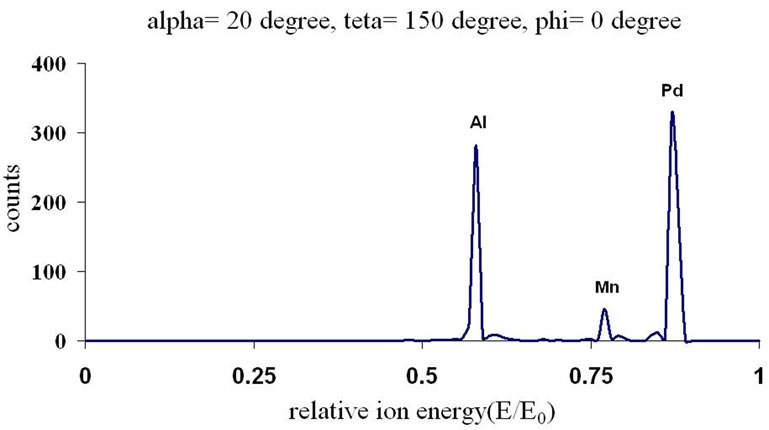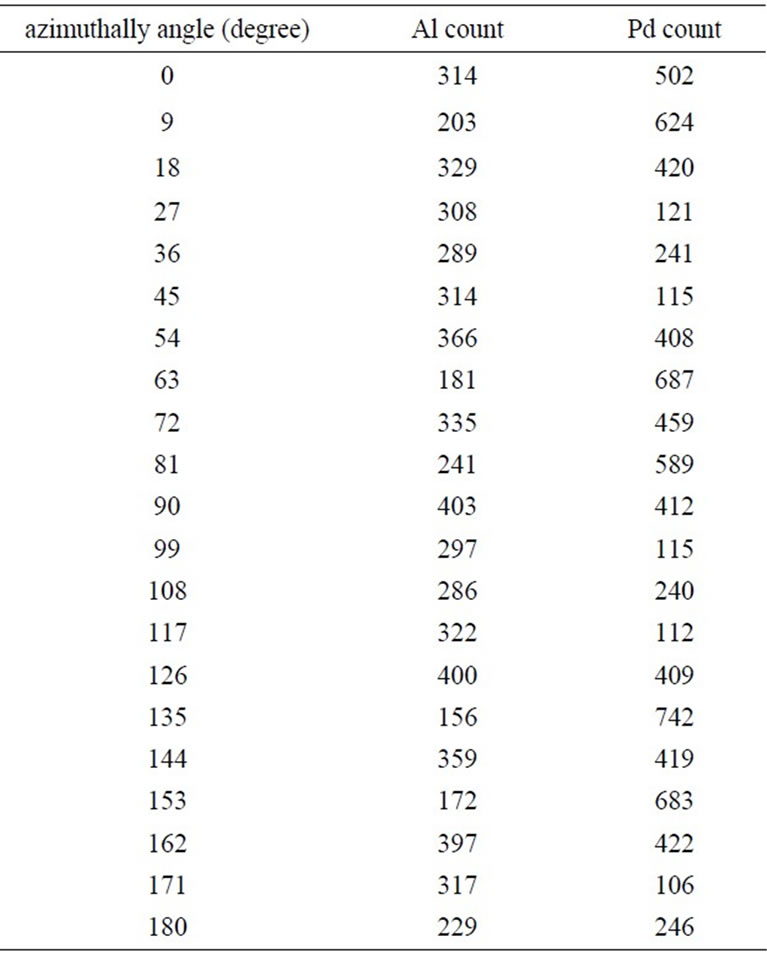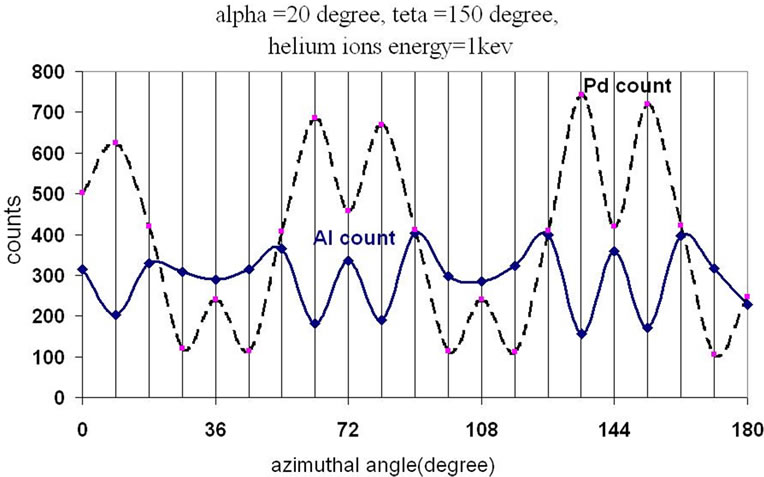Advances in Materials Physics and Chemistry
Vol.2 No.2(2012), Article ID:19974,3 pages DOI:10.4236/ampc.2012.22014
The Study of the Symmetry in the Surface Structure of a Quasicrystal Al-Pd-Mn
Department of Physics, Bu-Ali Sina University, Hamedan, Iran
Email: Fsamavat@basu.ac.ir, samavat@yahoo.com
Received February 14, 2012; revised March 14, 2012; accepted March 25, 2012
Keywords: Low Energy Ion Scattering (LEIS); SABRE Computer Program; Azimuthally Scan; Quasicrystal; Al-Pd-Mn
ABSTRACT
In this paper, we are going to study the surface structure and existing symmetry by simulation of a quasicrystal Al-PdMn. Quasicrystals have unique properties in their own structure. In the surface structure generally we should pay attention to two subjects. Firstly, what kind of atoms have situated on the surface and secondly the form of collecting atoms by each other sides. Usually, there are different ways for answer to these questions. In this study, Low Energy Ion Scattering (LEIS) technique has been applied. We select a representative cell by using gained information from Low Energy Electron Diffraction (LEED) technique, and give the information to the SABRE computer program. This computer program has been run for azimuthally angles 0 - 180 degrees in the intervals of 9 degree and its output has been analyzed for gaining azimuthally scan. The azimuthally scan shows the existing of a symmetry 72 degree on the surface of this quasicrystal.
1. Introduction
In contrast of crystalline materials in the solids, there are other materials that are called quasicrystals. Quasicrystals were first observed by Dan Shechtman in 1982 [1]. The word of quasicrystal is considered as a compendium for quasi periodic crystal. These materials are typically two ternary alloys often contain 60 to 70 percent aluminum. Quasicrystals are regular but do not have periodic structures. They have banned crystallographic symmetry, for example: they have the order of symmetries 5, 8 and 12-fold. They also show unusual properties such as low friction of coefficient, non-reactive properties (non adhesion), high hardness, friability, low surface energy and good cover resistance [2,3]. Some of these unusual properties are related to surface phenomena and this event has caused, surface science researchers study about these materials. Studies have shown that properties obtained from surface in most cases are different from the properties obtained from bulk of solid. To study, the surface of quasicrystals different techniques are used. Most techniques of surface structures, study multiple layers. It always leaves questions about the highest layers of a quasicrystal. So, our goal in this study is determination the structure and composition of the highest layer, by using of LEIS technique based on obtained data from LEED technique. LEED dynamic results for quasicrystal surface Al-Pd-Mn by Greer and colleagues, suggested that the highest level of quasicrystal certainly Should includes Al (about 90 percent Al and 10 percent Mn), with a secondary layer about 0.4 angstrom under which includes 49 percent Al atom, 42 percent Pd atom and 9 percent Mn atom [4,5].
2. Description and Introduction of LEIS Technique
The most sensitive and effective method for studying the highest surface is LEIS technique. It is a surface analysis technique which can determine the type and symmetry of atoms in the first and second layers of a material.
This technique was first applied to study the surface structure of solids by Smith in 1968 [6]. The surface sensitive LEIS technique and properties of the shadow and blocking cones have led to existence of powerful method for studying the structure of the uppest atomic layers. In this purpose a beam of single energy inert gas ions or alkali ions incidence on target atoms and after collision, they scattered and then are evident by detector. In this technique the distance between two atoms on the surface or the distance between the first and second surface layer with ion incident angle can be calculated by using concept of single and multiple scattering and blocking and shadow cones [7]. Also, there are two types of angular measurement: azimuthally scan and the polar scan. In polar scan, θ and φ that are scattering and azimuthally angles, are fixed and α namely incident angle is changeable [7].
With this type of scan can be obtained deep layers or the distance between them and determine the type of atoms in different layers. In a azimuthally scan can be measured intensity of scattered ions under variable angle φ by keeping constant the angle α and the scattering angle θ. With this scan and graph drawing heavily depending on the angle φ, we able to determine the symmetry of surface.
Generally azimuthally scan gives distance between atoms on the surface, how their placement on the surface and also, the surface structure. So here we will review despite the surface symmetry by using azimuthally scan.
3. Method of Investigation
SABRE computer program used to obtain the azimuthally spectrum. The program name is selected from the Surface Binary Event. It is used to simulate one of the interactions by following the trajectory of the projectile in the crystal. To run computer program, it is necessary to introduce a single cell to the program. For the representative cell, the data which obtained from the technique of LEED was used. Using this information, the representtative cell is introduced into the SABRE in the form of Figure 1.
The representative cell is given by the computer program instructions that came with a specific format. Then the computer program runs for the representative cell and output is analyzed by the program EXCEL. The energy spectrum of the output for the zero degree azimuthally angle has been shown in Figure 2 as an example.
This program is repeated identically with the same conditions for angles from 0 to 180 degrees to 9 degrees apart and the peak number of Al-Pd is given at any angle in Table 1. Finally, azimuthally scan to check the symmetry is drawn in Figure 3.

Figure 1. The representative cell chosen for running computer program simulation (SABRE).

Figure 2. Energy spectrum plotted for the azimuthally angle 0 degree.

Table 1. Obtained peaks for Al and Pd.

Figure 3. Azimuthally scan for α = 20˚, θ = 150˚ and He+ = 1 kev.
4. Conclusion
There is a clear and distinct peak in the energy spectrum shows that LEIS technique can be used effectively to identify the elements of the quasicrystal. On the other hand as azimuthally scan shows that there is symmetry of 72 degrees in the quasicrystal (Figure 3). There are peaks in the scan that happens at every 72 degrees, indicated in the quasicrystal symmetry is pentamerous. This symmetry is forbidden in terms of crystallography.
REFERENCES
- D. Shechtman, I. Blech, D. Gratias and J. W. Cahn, “Metallic Phase with Long-Range Orientation Order and No Translational Symmetry,” Physical Review Letters, Vol. 53, No. 20, 1984, pp. 1951-1953.
- F. Samavat, M. J. Gladys, C. J. Jenks, T. A. Lograsso, B. V. King and D. J. O’Connor, “Study of Preferential Sputtering and Segregation Effects on the Surface Composition of Al-Pd-Mn Quasicrystals,” Surface and Interface Analysis, Vol. 40, No. 3-4, 2008, pp. 433-435. doi:10.1002/sia.2769
- F. Samavat, M. J. Gladys, C. J. Jenks, T. A. Lograsso, B. V. King and D. J. O’Connor, “Surface Layer Self Diffusion in Icosahedra Al-Pd-Mn Quasicrystals,” Surface Science, Vol. 601, No. 24, 2007, pp. 5678-5682. doi:10.1016/j.susc.2007.06.043
- M. Gierer, M. A. Van Hove, A. I. Goldman, Z. Shen, S. L. Chang, C. J. Jenks, C. M. Zhang and P. A. Thiel, “Structural Analysis of the Fivefold Symmetric Surface of the Al70Pd21Mn9 Quasicrystal by Low Energy Electron Diffraction,” Physical Reviews Letters, Vol. 78, No. 3, 1997, pp. 467-470. doi:10.1103/PhysRevLett.78.467
- M. Gierer, M. A. Van Hove, A. I. Goldman, Z. Shen, S. L. Chang, P. J. Pinhero, C. J. Jenks, J. W. Anderegg, C. M. Zhang and P. A. Thiel, “Fivefold Surface of Quasicrystalline AlPdMn: Structure Determination Using Low-EnergyElectron Diffraction,” Physics Review B, Vol. 57, No. 13, 1998, pp. 7628-7641. doi:10.1103/PhysRevB.57.7628
- D. P. Smith, “Scattering of Low-Energy Nobel Gas Ions from Metal Surface,” Journal of Applied Physics, Vol. 38, No. 1, 1968, pp. 340-347. doi:10.1063/1.1708979
- F. Samavat, B. V. King and D. J. O’conner, “Low Energy Ion Scattering,” Surface Review and Letters, Vol. 14, No.1, 2007, pp. 31-41. doi:10.1142/S0218625X07009001

